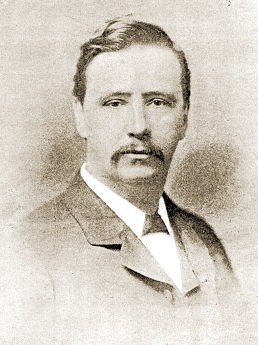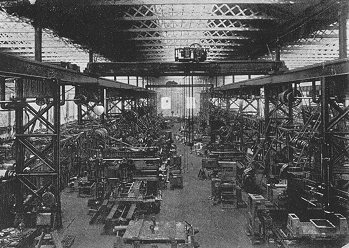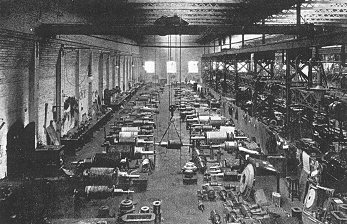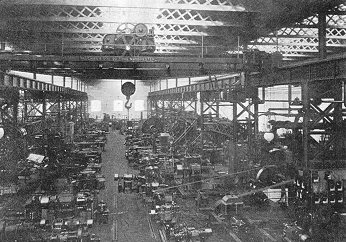|
Thomas Parker,
Limited
The following is from an article in the
Wolverhampton and South Staffordshire Illustrated, 1899.
Electrical Engineers and
Manufacturers, Wolverhampton
The remarkable discoveries in electrical science
recorded in the last decade of the fast-expiring century have had a
distinctly important bearing on the industrial development of
Wolverhampton, the locality selected as the site of one of the
largest engineering and manufacturing works of the kind in the
Kingdom. The establishment owes its existence and its subsequent
success to the indomitable energy of the founder, Mr. Thomas Parker,
J.P., a brief biographical sketch of whose career may appropriately
preface a description of the splendidly equipped works in
Wednesfield Road, recently visited by our representative, by the
courteous permission of the directors.
|
|

Mr. Thomas Parker, J.P. |
Quoting from an interesting article that appeared in
The Electrician Electrical Trades Directory for 1897, we learn
that Mr. Parker was born on December 22nd, 1843, at Ironbridge,
where his father, and several generations of the family before him,
had been employed in the great works of the Coalbrookdale Company.
At the age of 23, Mr. Parker migrated to Manchester, where, taking
advantage of the facilities of the Free Library, and the science
lectures at the Hulme Town Hall, he laid the foundation of a sound
technical education, invaluable to him in his after career.
Returning to Coalbrookdale, he was engaged as foreman over a portion
of the foundry, and shortly afterwards was promoted to more
congenial employment in charge of the chemical and
electro-depositing departments, and at this time constructed his
first dynamo, which was used for that process. |
| About 1877, Mr. Parker obtained a patent for a
steam pump, which was awarded a medal at the Inventions Exhibition,
and is still made by the Coalbrookdale Company. This invention was
succeeded by a design of grate manufactured by the Company under the
designation of the "Kyrle" grate, for which he obtained a first
medal at the Smoke Abatement Exhibition in London in 1880. About
this time Mr. Parker was again promoted to the important position of
manager of the engineering department of the Company's works, and in
1882 he showed Siemen's and Edison's incandescent lamps at a lecture
table by the aid of secondary batteries of his own design. About
this time he discovered the action of nitric acid as facilitating
the formation of secondary batteries, and in conjunction with Mr.
Elwell took out a patent in 1882, in which the novelty of this
chemical agent was claimed. This patent, which was afterwards
divided by the Solicitor General between M. Gaston Planté and Mr.
Parker, also covered several of the most important forms of
alternating current dynamos in use today. Shortly afterwards, Mr.
Parker resigned his connection with the Coalbrookdale Company, and
in partnership with Mr. Paul Bedford Elwell, commenced business in
Wolverhampton as Elwell Parker. This was further developed in 1884
as Elwell-Parker, Limited, and in the same year he fulfilled the
important contract for the installation of the electrical plant of
the Blackpool Tramways Company, for which he remained consulting
engineer until 1892. |
| Since 1884, Mr. Parker has introduced several
inventions, both by himself and in association with others, having
also made the manufacture of phosphorus by electricity a success. At
this period Mr. J. Oddie, who was travelling from Australia for
information on electrical knowledge and its developments, found Mr.
Parker, and was so impressed with him and his position in the
developments of that time, that he paid the celebrated painter,
Goodwyn Lewis, to paint a picture of Mr. Parker and his specialities
at that time (1889). |

The Tool Bay. |
|
This picture, 7ft. by 5ft., was exhibited in the Art
Gallery at Wolverhampton, and was presented to the Art Gallery at
Ballarat. Mr. Oddie was Ballarat’s first Chairman of
the Municipal Council, from 1856 to 1858 and has been a great
donor to that town.
In 1882 an amalgamation between Elwell-Parker,
Limited, and other concerns was effected, under the title of the
Electric Construction Corporation, Limited, of which he was
appointed engineer and manager. In 1890 the premises occupied by the
Corporation in Commercial Road became inadequate to the requirements
of the rapidly expanding business, and Mr. Parker was deputed to lay
out elaborate works at Bushbury just outside the town, and under his
supervision the establishment was fitted with complete plant for the
manufacture of heavy electrical machinery.
During the term of his engagement with the
Corporation Mr. Parker carried out many large installations in
connection with electric traction, including the whole equipment of
the Liverpool Overhead Railway, the overhead system in South
Staffordshire, the lighting of the City of Oxford (the method is now
known as the Oxford system, and has been largely adopted), and the
installation at Burnley, etc., while more recently he has executed
contracts for the supply of machinery for central station lighting,
including plant for the Walsall Corporation (continuous- current,
2,000 Volts); Wolverhampton Corporation (extension,
continuous-current, 2,000 volts); Shrewsbury Electric Lighting
Company, Limited, Chester, Sunderland, Manchester Corporations,
etc., and has lately completed contracts for central station
electric lighting plant for Hull, Belfast, Morecambe, and several
other towns.
|
|

The Winding Department. |
Mr. Parker was admitted a member of the Institution
of Electrical Engineers in 1885, a member of the Institution of
Civil Engineers, 1889; member of the Institution of Mechanical
Engineers, 1891; member of the Royal Society of Edinburgh, 1892.
In
1892 Mr. Parker contested the county constituency of Kingswinford
for Parliament against Mr. Staveley Hill, Q.C., and in 1893 he was
made a Justice of the Peace for Wolverhampton. |
|
In the Spring Session of 1894, Mr. Parker read a paper
on the Liverpool Overhead Railway before the Institute of Civil
Engineers, for which that body granted him a Stephenson Medal and
the Telford Premium.
On the termination of his agreement with the Electric
Construction Corporation, in April, 1894, Mr. Parker relinquished
his connection with the concern, and established " Thomas Parker,
Limited," of which he became managing director. From the first, the
operations of the company have been crowned with notable success, as
may be estimated from the fact that at the close of the financial
year in April, 1896, a dividend of 5 per cent. was declared, and in
the following year this was increased to 7 per cent. and in 1898, 8
per cent., the £10 shares now being quoted on the Birmingham Stock
Exchange at 16. Possessing exceptional advantages in a practical
experience of the organisation and fitting up of similar works, Mr.
Parker was fully qualified to design the arrangement of the premises
on the most efficient methods for the various departments of an
engineering and electrical business, of which we may present the
following details of the more salient points of interest observed in
our tour of inspection.
Situated opposite the goods depot of the Midland
Railway, the works have an extensive and imposing frontage to
Wednesfield Road, where the general and private offices, board room
and drawing offices, are situated. The works proper cover a large
area of ground, and comprise a range of commodious buildings, of
which the principal structure occupies a floor space of 35,000
square feet, superficial. This immense shop is of lofty proportions,
admirably lighted by the glass roof, well ventilated, and
conveniently arranged for the accommodation of the several sections
of the works, grouped in the building.
|
| At one end, a balcony reached by a staircase
stretches across, in which a number of female hands are busily
employed in the more delicate branches of the work, principally
connected with the insulation process.
One side of the building is
fitted with benches occupied by the operatives building and
insulating blocks and preparing the cores for dynamos and motors, of
which there were numbers in the course of construction from 10 to
2,500 volts pressure. |

The Erection Bay. |
|
Another department, screened off from the main
portion, is also occupied by female workers, of whom about 120 are
employed in the establishment. At the extreme end of the shop is the
brass workers department, fitted with machines of various kinds for
turning, polishing, and finishing component parts and accessories
used in electrical construction. In the centre of the building, a
large space is devoted to the different types of heavy machinery.
These include drilling, milling, shaping, planing, slotting and
other machine tools, embodying the latest improvements in mechanical
science, specially designed to economise labour and time, and thus
lessen the cost of production. In this class of machinery we
observed some splendid specimens of engineering skill in the drills
supplied by Muir and Co., Manchester; Campbell and Hunter, Leeds;
Archdale and Co., Birmingham; plano-millers by Muir, Campbell and
Hunter, and Tangye's; side planer by Hulse and Co., Manchester; the
whole forming a complete plant of the most modern and approved
description.
The transport of heavy material and portions of
machinery is facilitated by three large overhead travellers and
three hand cranes, the former capable of lifting from 5 to 20 tons,
by which articles can be conveyed from one end of the shop to the
other, and tram lines are also laid down for bringing the castings
from the adjacent foundries. The first of these used for brass
casting is a large, lofty and well lighted building, fitted with all
the requisites for moulding the patterns and melting the metal, and
this description will equally apply to the iron foundry, a more
extensive department, measuring 40 feet by 100 feet, and of
corresponding height. This is furnished with a large oven for drying
the cores, and a travelling crane capable of hoisting a weight of 10
tons. There is also a blower house, containing an electrical motor
of 8h.p. Next to this is another spacious shop 80 feet by 40 feet,
where the pattern making is carried out by the aid of improved
wood-working machinery, and there is also a large store for the
extensive stock of patterns required in the various manufactures
turned out. All the machinery is driven by electrical power, the
motors being fixed in various parts of the works, and are all of the
firm's standard designs.
Every detail of the arrangements is characterised by
the perfection of systematic order, and during a somewhat extensive
experience of such establishments it has seldom fallen to our lot to
meet with a more completely organised and ably administered concern.
About seven hundred hands are employed in the several sections of
the works; and we may mention that the gentlemen who have laboured
with Mr. Parker in this enterprise as his staff, are mostly chosen
from his pupils of years past. We have to acknowledge our
indebtedness for the facilities afforded in the compilation of this
necessarily abridged description of the business.
In conclusion, we may add that the firm was awarded a
gold medal for high-speed railway motors at the International
Exhibition, held at Brussels, in 1897.
At the present time (March, 1899) the Directorate of
the Company is composed as follows C. T. Mander, Esq., J.P.
(Chairman); William Thomas, Esq., Richard Armistead, Esq., and
Thomas Parker, Esq. (Managing Director).

|
Return to the
previous page |
|
|